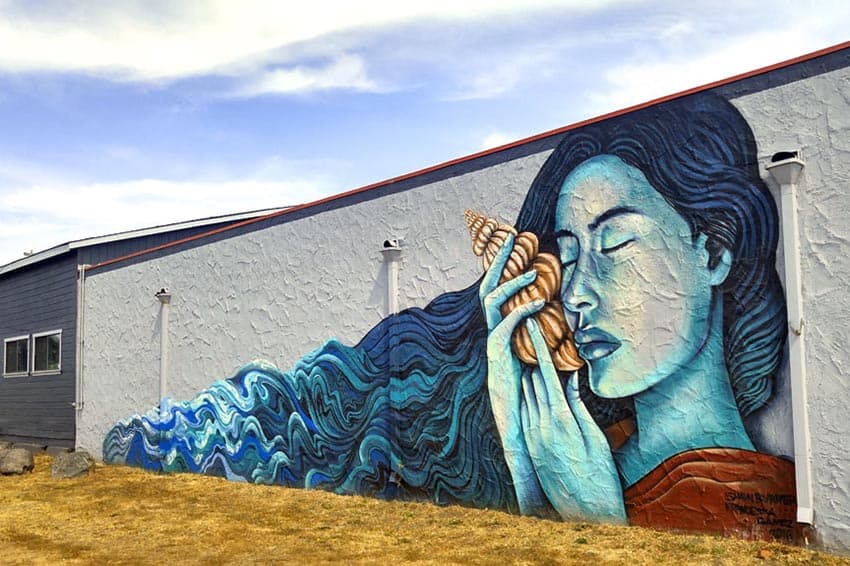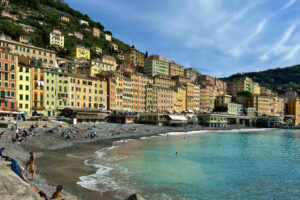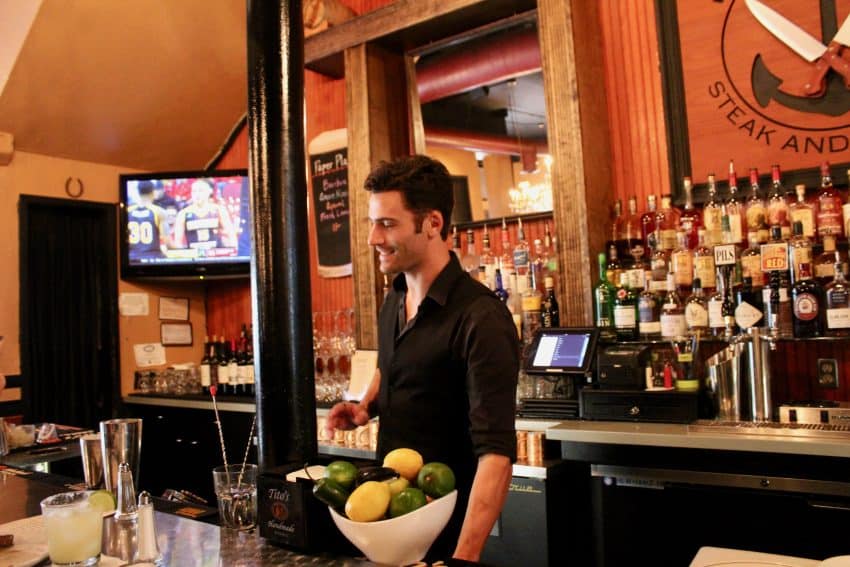
A Road trip from Sacramento to Mendocino on a May Morning
By Max Hartshorne
GoNOMAD Editor
Sacramento to Mendocino California road trip: Rolling down Highway 101 west in my red Corolla rental with just 159 miles on it, I blasted my music, Fiest, at a scintillatingly loud volume.

Why not? I was alone and I had 200 lovely miles ahead of me. I would wind my way through the vineyards of Napa and Sonoma counties, and then the Alexander Valley — the heart of wine country.
Up to Fort Bragg
Then I’d head north, hard by the Pacific, and continue up all the way to the edge of the map to Fort Bragg. It’s a spec of a town, and I’ll find my accommodations there. Then I’ll drive down to the Noyo River to get into the water with Liquid Fusion Kayaks.
We adventured up the road through towns with California Gold Rush era names… Sutter’s Mill and Volcano. We turned there to find the Indian Grinding Rock State Historic Park, a series of holes once used by the Miwok Indians to grind their staple — acorns — into a flour to bake cakes.
It’s now a California state park, with an interpretive hiking trail. The South Nature Trail is a half-mile loop that leads through a diverse natural area of meadow, creekside, oak woods, and coniferous forests.

Indian Grinding Rock State Park
The flat rock is like a giant black whale, lying 50 or 60 feet across, and here are the holes… some barely dents, others well-worn and used often, then those that are so deep the acorns might have gotten lost.
Nearby are five tipis, shaped in the traditional spired way, yet these have skins of rough oak trees.
Down a path is the ceremonial roundhouse, where a large fire pit and a hole in the top to let out smoke, and where dances and elaborate Native American ceremonies were performed.
In the woods, we sat for a moment, being careful to deliberately avoid making any noise….and let the sound of the forest creep into us.
As a distant car eventually drove out of earshot, we were left with a soft silence. We hushed our bodies and remained still, squeezing all of the extra noise out for this moment.
Then a particularly sharp cry of a nearby, unidentified bird broke the murmur of the forest canopy. And later, an owl hooted faintly.
Through the Forest to Mendo County

Mendocino County is the most sparsely populated county in California. There are nine Indian reservations in the county of 87,500 people recorded in 2019. That’s empty!
Two million acres, about 3,500 square miles, of gorgeous redwoods; thousands of acres of ranches, farms, and vineyards, 100-miles of the coast with crashing waves, deserted beaches, and spotty cellphone reception.
Fort Bragg
Back on the road again, the coastal town of Fort Bragg surprised me. It’s a former mill town, of about 7500 residents. The most desirable beachfront real estate is a 400-acre former Georgia Pacific lumber mill that closed in 1972.
Today, the mill buildings are gone. The deserted mill site has become a sanctuary for birds, mammals, and plants.
Coastal Trail

With the timber industry gone, this spectacular location now has a 10-mile, all-access paved trail skirting the Pacific headlands. It’s also part of the California Coastal Trail.
Along the way, interpretive panels illuminate history, nature, and the lives of the first residents, the Pomo Indians.
Wave and whale watching seats, and tables for picnicking dot the path. All are made by local artists from repurposed boat wrecks and recycled redwood barns. It’s like walking through an outdoor sculpture gallery where you’re encouraged to touch the art.
I learned that Fort Bragg was once a hardscrabble, timber and fishing village, Bohemian neighbor to smaller, more genteel, Mendocino. In the New England-looking village of Mendocino, the fishing and timber industries got a start but didn’t last as long as they did in Fort Bragg.
Downtown
Fort Bragg has a vibrant Main Street and historic downtown district. Local shops, eateries, museums, a marine science center, Town Hall, and a pocket park are housed in early 20th-century and Victorian-era buildings.
A mural walk of this 6-square block district showcases artistic talent from all corners of the region. The alley and building murals are stunning with culture, history, and nature themes. website

All Aboard
One block off Main, I found another cool attraction… the Skunk Train.
In the days before roads and trucks could do the job, trains brought behemoth redwoods from the forest to the mills. The 133-year-old Skunk Train made it possible to move gigantic redwoods from remote mountain forest to lumber mills in coastal and inland towns.
Today the train is classified as historic. Excursions vary from a 1-hour Pudding Creek Express, roundtrip from coastal Fort Bragg, or the 4.5-hour Northspur Flyer, roundtrip from inland Willits.
Another way to experience the railroad and the magnificent redwoods along Pudding Creek Estuary are rail bikes, pedal-powered, motor-assisted vehicles that ride the rails leaving Fort Bragg and riding to Glen Blair Junction. After a stop for a little history and nature talk, the bikes are turned around, and you return to Fort Bragg. website
Living Light Institute
One of the highlights of Fort Bragg was the Living Light Institute. They have a pop-up cafe, two B&Bs, and a school where the techniques of raw and cooked vegan cuisine are taught.

You can take classes in vegan cuisine, and learn how to be a vegan chef or caterer. Classes are offered in basic kitchen skills, baking, fermenting, coastal gardening, and mind-body wellness.
Special pop-up vegan dinners are cooked and served at the institute’s classroom and event center located in the Company Store building.
If you want to stay over, they have two B&Bs, Redwood Coast Inn and Living Light Inn, popular with tourist and students bunking down for the rigorous week of culinary training.
The day I stopped by, cheerful women were thinly slicing zucchini to roll up with savories like nuts, dried fruits, and spices from around the world. website
How About Noyo Instead?
Our kayaking guide, Cate Hawthorne, told me that Fort Bragg residents periodically bring up the idea of changing the name of the town. Since most people associate the name with the big army base in North Carolina (it’s named for a man who never even set foot in the town!), maybe someday the burgh will be named for the scenic river that flows out to the Pacific, the Noyo.
We got into two-person ocean kayaks and glided out to the sea with the outgoing tide, a perfect sunset twilight time to get into the water. The scenery of the cliffs where the river meets the ocean was majestic and calming.
Passing under the tall bridge that supports CA Hwy 1, we watched the many sea birds — pelagic cormorants, ospreys, belted kingfishers, predators who seek out fish by diving and swimming after their prey.

In the waning twilight, we paddled the agile two-person ocean kayaks with ease.
In our party was a girl of about nine who seemed almost mute — too nervous to utter any sentences, terrified by simple questions tossed out by the guide. But she did well with her paddling.
When paddling up the Noyo River, we went past the five or six nests of the river otters. The creatures always have that many dens, sort of safe houses in case of floods or predators.
Sea Lions and River Otters
Beneath the pier, across from where a Coast Guard fast rescue boat was docked, was a pier where sea lions played. The big lions are twice as big as their sleeker, smaller cousins, the seals, both of them frolic with abandon and without much fear of man.
There are river otters here too, though, sadly, none popped up during my float-by. We went past wooden fences in the river, once used to handle the logs that flowed downstream from the bounteous redwood forests of Mendocino County. There were once 274 sawmills; today none. They just ran out of redwoods to cut down!

Preserving Mendocino
That night at dinner, at the now-closed Cliff House, I was joined by Richard Strom, who told me that he’d just sold a B&B in Mendocino. He worked for Visit Mendocino, talking about the place he’s adopted as home.
“Murder She Wrote,” was filmed here, he said. “And in the town of Mendocino, you can’t have solar panels, thermal pane windows, skylights or anything too modern.” He said that these strict historic preservation rules keep many people out.
Later I took a walk with an artist friend who lives in nearby Little River. He showed me a huge open field next to the beach.
“A big hotel was planned for right here,” he said. “They had to give it up because of the lack of a large supply of water.”
So, this explained those water towers I kept seeing. It just doesn’t rain much in Mendocino, so big developments have a hard time moving forward. And there aren’t that many people here to work there or patronize it.
I asked Richard about the topic that many people quickly associate with the name Mendocino: Marijuana. “Oh, that. Let’s not go there. There are many things more important than that.”
But what he’s referring to is an underground economy of nearly $1.5 billion. Scores of locals have good jobs trimming marijuana buds, part-time work that pays $25 per hour*.
Now that the state has legalized pot, legal and illegal growers are being converted to licit farmers. Some have struggles.
California cannabis laws allow each community to decide how, and where cannabis growers; cannabis product producers (oils, edibles, etc.), distributors, and retailers can conduct business.
In Mendocino County many long-term, and licensed Medical Cannabis growers and producers were promised a ‘way forward’ to become legal under new regulations.
-

Cannabis farm, Mendocino County CA - Tough Health Codes
A big stumbling block is causing some growers to go bankrupt. In Mendocino County, you can’t apply for one a license until your property and facilities meet current building and health codes. An insurmountable task for those working with older barns and agricultural equipment.
Additionally, the licensing process is long and confusing, opening the doors for companies that specialize in getting you through the convoluted process. For a fee of course.
While the industry grows and new dispensaries (pot shops), and farms are licensed daily, many veterans of the business have gone deep underground or closed altogether, giving a healthy share of the market to corporate growers.
Slow down, you’re on Mendo-time.
Our trip was sponsored by Visit Mendocino, find out more about where to eat, sleep, and play at Visit Mendocino County.
*Those $25 per hour jobs mentioned earlier still exist, but the job-pool is shrinking, while the labor force is growing. Please, don’t go to Mendocino County looking to ‘trim’. Strangers are never asked into the inner-sanctum. Growers only hire vetted and experienced staff.
- Chicago: The Perfect Weekend Jaunt - August 17, 2024
- Quebec’s Eastern Townships and Magog - August 3, 2024
- Exploring California’s Empty Central Coast - April 24, 2024






Glad you like it.